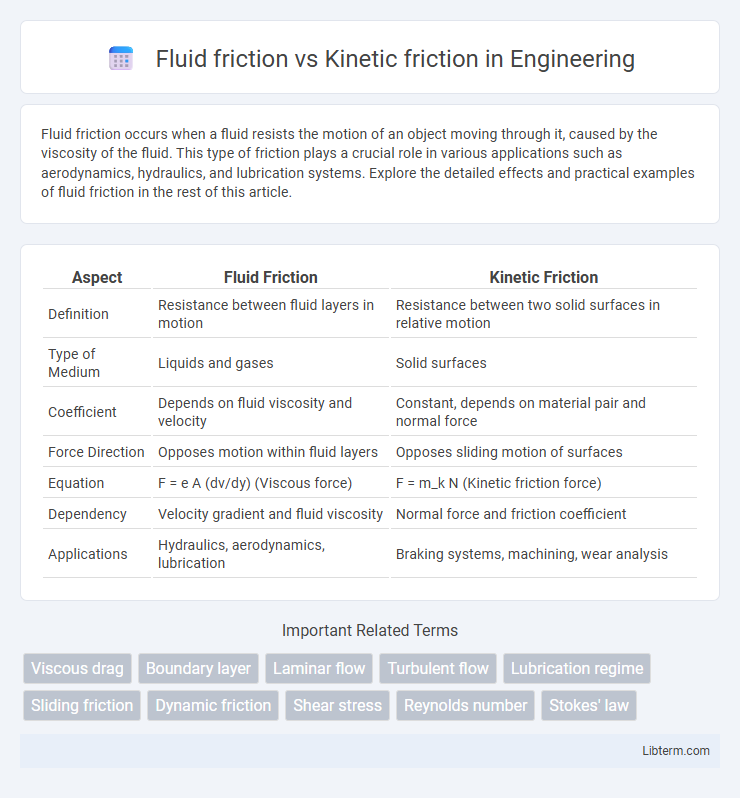Fluid friction occurs when a fluid resists the motion of an object moving through it, caused by the viscosity of the fluid. This type of friction plays a crucial role in various applications such as aerodynamics, hydraulics, and lubrication systems. Explore the detailed effects and practical examples of fluid friction in the rest of this article.
Table of Comparison
| Aspect | Fluid Friction | Kinetic Friction |
|---|---|---|
| Definition | Resistance between fluid layers in motion | Resistance between two solid surfaces in relative motion |
| Type of Medium | Liquids and gases | Solid surfaces |
| Coefficient | Depends on fluid viscosity and velocity | Constant, depends on material pair and normal force |
| Force Direction | Opposes motion within fluid layers | Opposes sliding motion of surfaces |
| Equation | F = e A (dv/dy) (Viscous force) | F = m_k N (Kinetic friction force) |
| Dependency | Velocity gradient and fluid viscosity | Normal force and friction coefficient |
| Applications | Hydraulics, aerodynamics, lubrication | Braking systems, machining, wear analysis |
Introduction to Fluid Friction and Kinetic Friction
Fluid friction occurs when a solid object moves through a liquid or gas, causing resistance due to the interaction with fluid particles, while kinetic friction acts between two solid surfaces sliding past each other. Fluid friction depends on factors such as fluid viscosity, object shape, and velocity, whereas kinetic friction is influenced by the nature of the surfaces and the normal force pressing them together. Understanding the distinctions between fluid friction and kinetic friction is essential for applications in engineering, physics, and biomechanics.
Defining Fluid Friction
Fluid friction, also known as drag, occurs when an object moves through a liquid or gas, causing resistance due to the fluid's viscosity. This type of friction depends on factors such as the fluid's density, velocity of the object, and surface area in contact with the fluid. Unlike kinetic friction, which arises from direct contact between solid surfaces in relative motion, fluid friction involves the interaction between an object's surface and the fluid particles.
Understanding Kinetic Friction
Kinetic friction acts between two solid surfaces sliding past each other, characterized by a constant force opposing motion once movement begins. It differs from fluid friction, which involves resistance through liquids or gases and depends on factors like viscosity and flow speed. Understanding kinetic friction involves analyzing surface texture, normal force, and the coefficient of kinetic friction specific to the material pair.
Key Differences Between Fluid Friction and Kinetic Friction
Fluid friction occurs when an object moves through a liquid or gas, causing resistance due to the viscosity of the fluid, while kinetic friction acts between two solid surfaces sliding past each other. Fluid friction depends on factors like fluid velocity, viscosity, and object shape, whereas kinetic friction is influenced by the normal force and the materials in contact. Unlike kinetic friction, which has a relatively constant coefficient for given materials, fluid friction varies continuously with changes in speed and fluid properties.
Factors Affecting Fluid Friction
Fluid friction depends on factors such as fluid viscosity, object speed, and surface area in contact with the fluid. Higher viscosity fluids, like honey, create greater resistance compared to low viscosity fluids like water. Increasing the speed of an object moving through a fluid or enlarging its surface area results in higher fluid friction forces.
Factors Influencing Kinetic Friction
Kinetic friction depends primarily on the nature of the surfaces in contact and the normal force pressing them together. Surface roughness, material composition, and the presence of lubricants significantly alter the frictional force during relative motion. Unlike fluid friction, which is influenced by fluid viscosity and flow velocity, kinetic friction remains largely constant regardless of sliding speed.
Real-World Examples of Fluid Friction
Fluid friction occurs when an object moves through a liquid or gas, such as a swimmer pushing through water or an airplane flying through air, causing resistance that slows motion. Kinetic friction acts between solid surfaces in relative motion, like a sled sliding on snow or car tires skidding on pavement. Real-world examples of fluid friction include the viscous drag experienced by oil flowing through engine parts and the aerodynamic drag on a cyclist riding against the wind.
Practical Applications of Kinetic Friction
Kinetic friction plays a crucial role in practical applications such as braking systems in vehicles, where it opposes motion to enable control and safety. It is essential in everyday objects like conveyor belts and ball bearings, providing necessary resistance to control movement and prevent slipping. In contrast, fluid friction is more relevant in contexts involving the flow of liquids and gases, such as aerodynamics and hydrodynamics, impacting the efficiency of propulsion and machinery.
Comparative Effects on Motion and Energy Loss
Fluid friction occurs when an object moves through a liquid or gas, creating resistance that depends on the object's speed, shape, and the fluid's viscosity, resulting in continuous energy loss through turbulence and drag forces. Kinetic friction, acting between solid surfaces in relative motion, produces a nearly constant resistive force independent of speed but proportional to the normal force, converting mechanical energy directly into heat. Comparing both, fluid friction generally causes greater energy dissipation at higher velocities due to increasing drag, while kinetic friction leads to steady energy loss primarily during surface contact and sliding motion.
Summary: Fluid Friction vs Kinetic Friction
Fluid friction occurs when an object moves through a liquid or gas, causing resistance due to the fluid's viscosity. Kinetic friction acts between solid surfaces in relative motion, arising from microscopic irregularities and adhesion at the contact points. Fluid friction depends on factors like velocity and fluid density, whereas kinetic friction is influenced by the normal force and the materials in contact.
Fluid friction Infographic

 libterm.com
libterm.com